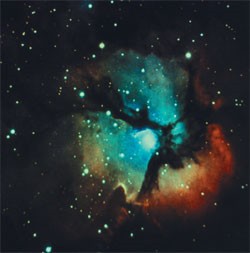About dark matter and parallel universes
 The topic has been edited so as not to mislead people, and also not to be so naive. Hey. I came across this news in the evening and thought about it all night. And what if there is no dark matter (read the article, by the way)? It so happened that over the past few days I have been stumbling across conversations about parallel worlds (in Beyond the Boundary, in the news, even in Futurama). And so, my brain combined these two things and came up with a theory.
The topic has been edited so as not to mislead people, and also not to be so naive. Hey. I came across this news in the evening and thought about it all night. And what if there is no dark matter (read the article, by the way)? It so happened that over the past few days I have been stumbling across conversations about parallel worlds (in Beyond the Boundary, in the news, even in Futurama). And so, my brain combined these two things and came up with a theory.So, the idea: what if there is no dark matter, and the gravitational background, which is supposedly created by it - is the sum of the influence of gravitational fields of objects in parallel universes on a given area in the space of our universe ?
Suppose there is an object with mass m , but it exerts a gravitational effect such as if the mass of the object is m 1 = 10m . Based on the theories about dark matter, this means that around this object there is still a bunch of invisible and in no way detectable substance, which compensates for the mass deficit. The same applies to the case when, seemingly, an empty region of space exerts a surprisingly large gravitational influence on neighboring objects. Again, this invisible dark matter is to blame.
What else can create such an effect? My idea is that in addition to our observable mass, there are other objects with similar x , y , z coordinates (and maybe t ), but located in parallel universes. It is logical to assume that these universes can be located relative to our universe in any way, which means that identical objects in different parallel universes will affect an object in our universe with different strengths. An object in the nearest parallel universe will act at a given point of our universe with the force p (U, U 1 ) F (m 1 ) , the next with the force p (U, U 2 ) F (m 2 ) , where p (U, U i ) is the coefficient of the force of influence of an object in the universe U i (we can assume that U is the coordinate axis on which parallel worlds are located, but it’s not necessary to count) on an object in our universe, and m i are the masses of corresponding objects in parallel worlds. And so on until the force of influence becomes negligible due to the fact that the parallel universe is too far from ours.
In other words, objects that have sufficient mass, for example, stars, create a gravitational field of such a force that it breaks the fabric of space or, perhaps, just seeps through it and, thus, spreads its influence into the neighboring parallel universes.Further, if neighboring parallel universes are not very different from ours in their configuration, then where we have, for example, a cluster of stars, there is something similar in the parallel world, and therefore at this point the total effect of all the gravitational fields of all neighboring universes. On the other hand, there may exist such a parallel universe, in which, for example, time moves at a different speed, so the configuration of the stars there is completely different. Because of this, there is an incomprehensible gravitational background from scratch in our universe.
Thanks to those who wrote constructive comments.
')
Source: https://habr.com/ru/post/59776/
All Articles